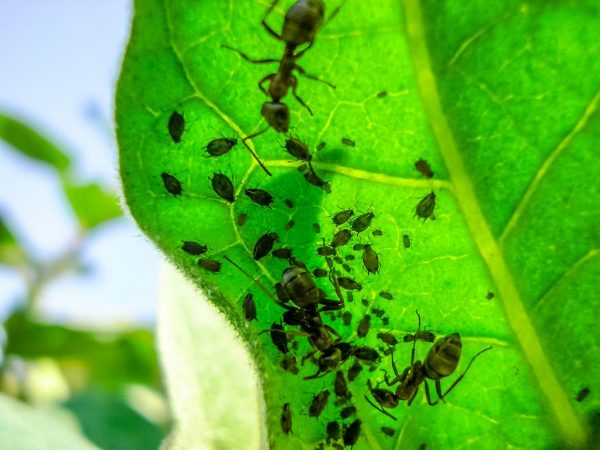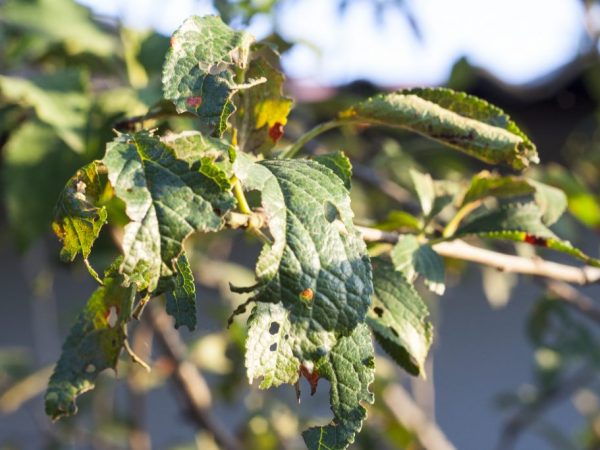Fighting aphids on a pear
Aphids on a pear can destroy the crop and, in some cases, lead to the death of the plant. The reasons for the appearance of aphids and how to deal with it will be discussed in the article.

Fighting aphids on a pear
What is aphid
The pear aphid is a very small insect, its size is only 0.55-2.0 mm. The pest sucking on plant sap is spread throughout the entire domestic territory, in the southern part of Europe, in the Caucasus region and in Central Asia.
The problem of detection is associated with the fact that the insect merges with the foliage and becomes unobtrusive.
Harm
With the appearance of aphids on the pear, the foliage of the plant begins to change in shape and size, and then curl. Aphids suck moisture from the juicy parts of the pear tree: inflorescences, young shoots, buds and young leaves. As a result, the plant loses its vitality, slows down growth, throws off flowers and ovaries.
Signs of appearance
The primary signs of the appearance of aphids on a pear are:
- sticky sweetish bloom (pad) on certain parts of the tree: on branches, foliage, soil near the trunk,
- bloom on fresh pear shoots and inflorescences of a black-brown hue - sooty fungus,
- twisted and withered foliage
- fallen inflorescences and ovaries,
- a lilac shade in the fruit in places where the pest has bitten the fruit.
In advanced cases, aphids on a pear completely cover all branches and leaves, and its colonies increase. During the summer season, insects are able to reproduce 12-16 generations, capturing the entire pear tree.
Prophylaxis
You can save the pear harvest from aphids with the help of preventive measures.
Landing place
The most suitable place to plant a pear tree is in an open, well-lit area. The pest prefers secluded, shaded areas and rarely chooses trees in direct sunlight.
Preparing the garden for wintering
After the harvest has been harvested, it is important to properly prepare the garden for winter. First of all, they remove all garden debris, make a bedding of dry fallen leaves, destroy weeds in order to remove biomass, in which the larvae of leafworms hibernate.
Useful neighbors
Gardeners are planted next to a fruit tree of neighbors who can scare off the pest with a pungent smell:
- bow,
- garlic,
- greens: parsley, dill, celery,
- herbs: mint, lavender and calendula,
- carrots.
These plants also attract the enemies of aphids: the ladybug, the lacewing, the hoverfly.
Balanced diet
In the fight against aphids, plant nutrition also plays an important role:
- in the spring, nitrogen-containing salts are introduced immediately after the snow melts and organic matter at the end of the flowering stage,
- in summer, the soil is fertilized with nitrogen-containing complexes that increase the resistance of plants to pests,
- in autumn, the land is fed with potassium and phosphorus, ash and organic matter.
Aphid control

Disinfection helps get rid of insects
You can fight the pest by disinfection. It is held both in late autumn and in the first month of spring.Autumn treatment against aphids is carried out when all the foliage has flown, and spring - before the buds have blossomed on the tree.
Intestinal complexes
Complexes that have a detrimental effect on the parasite when it enters its intestines are an effective remedy that retains an active defense for 3 weeks.
Among the disadvantages of such complexes, their long-term withdrawal from plants is noted, therefore they are inapplicable at the flowering stage.
Known drugs:
- Aktelik. It is used for spraying. The working fluid is made from 2 ml of active substance and 2 liters of water. The consumption rate depends on the size of the plant and is 2-5 liters.
- Bankcol. It is also intended for spraying fruit trees, for which 5-7 g of the active substance is dissolved in a 10-liter volume of water. The consumption rate of the working fluid is 10 liters per 100 sq. m of garden area.
Complexes of systemic exposure
Such treatment protects pear plantings from pests for a period of more than 4 weeks, is not washed off with water during irrigation and in rainy weather, and has a detrimental effect on other pests parasitizing the pear.
Among the shortcomings, a long elimination is noted, therefore such complexes are considered the most dangerous to human health. They take effect only after 2 weeks.
Known drugs:
- Aktara. For spraying, 8 g of active ingredient are diluted in a 10 liter volume of water. Consumption rate - 2-5 liters per plant.
- Biotlin. The working fluid requires 3 ml of active substance dissolved in a 10 liter volume of water. Consumption rate - 2-5 liters per tree.
Contact exposure complexes
The drugs penetrate the parasite through the surface of its body. At the same time, the processing solutions are not absorbed either into the trees themselves or into its fruits. They also have a detrimental effect on other types of pests, for example, the moth or weevil.
The drugs are less potent, so several treatments are required.
Known drugs: Fufanon, or Karbofos, 75 g of which is diluted in a 10-liter volume of water and sprayed with it on trees. Consumption rate - 2-5 liters per tree.
Traditional methods
Herbs
Dandelion and chamomile can be effective against aphids on pears when brewed.
For herbal infusion, 0.5 kg of stems and 1 liter of water are required. The mixture is kept for a day, then boiled for 15 minutes, 2 chopped garlic heads are added, boiled for another 5 minutes, filtered, diluted with water to a volume of 10 liters and 30 g of soap is added. It is necessary to spray with herbal decoction every 7 days in the evening.
Tops
Tomato and potato tops, infused throughout the day, also helps to get rid of the leaf roll.
1 kg of tops, filled with a 10-liter volume of water, is kept for a day, and before treatment is diluted in a mixture of 40 g of laundry soap. The foliage of the trees is sprayed with tops every 7 days in the evening.
Soap
The green crown is sprayed with a solution of soap every 7 days in the evenings. To do this, rub 2 pieces of laundry soap and pour 10 liters of warm water into it, stir until it is completely dissolved.
Tobacco
You can fight aphids on a pear with tobacco:
- tobacco dust, which is made by grinding dry tobacco leaves to a powder state, is sprayed from the underside of the leaf blades,
- tobacco infusion prepared from 0.5 kg of tobacco waste and 10 liters of water, aged for 2 days and mixed with 50 g of laundry soap, is also sprayed on the inner side of the leaves.


